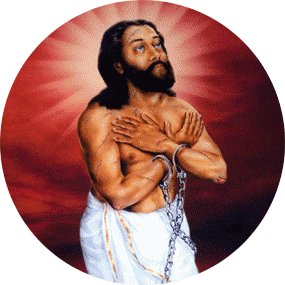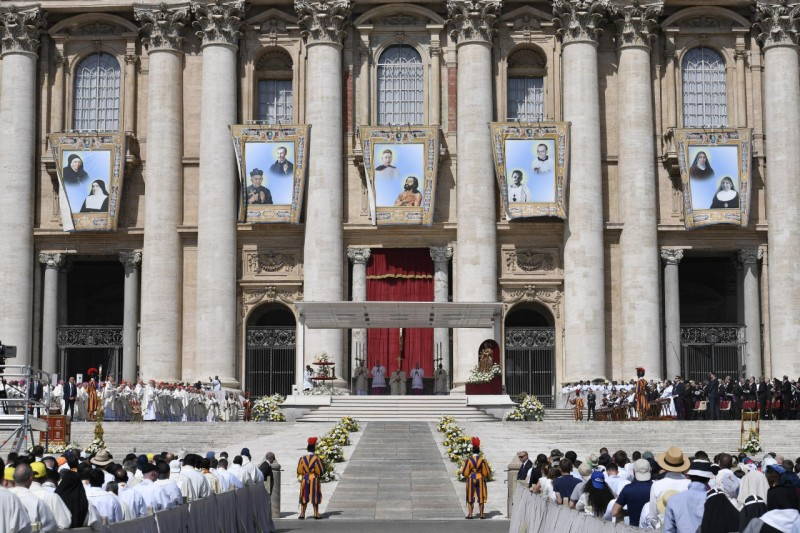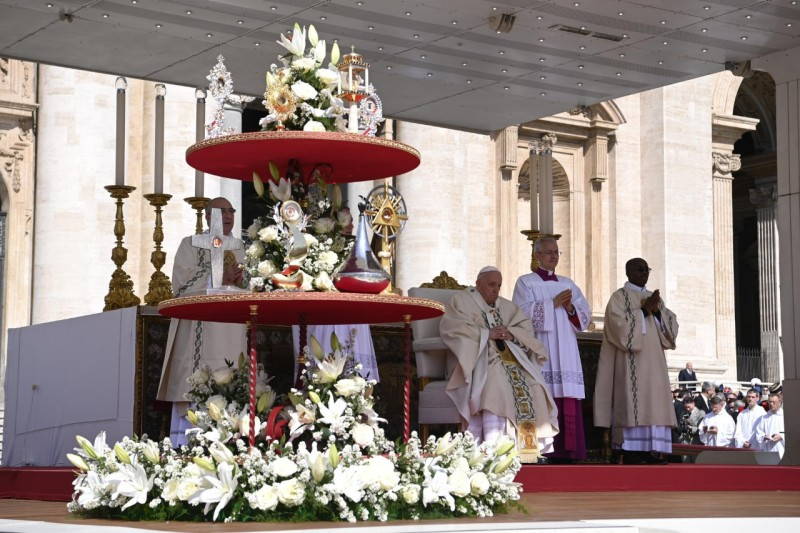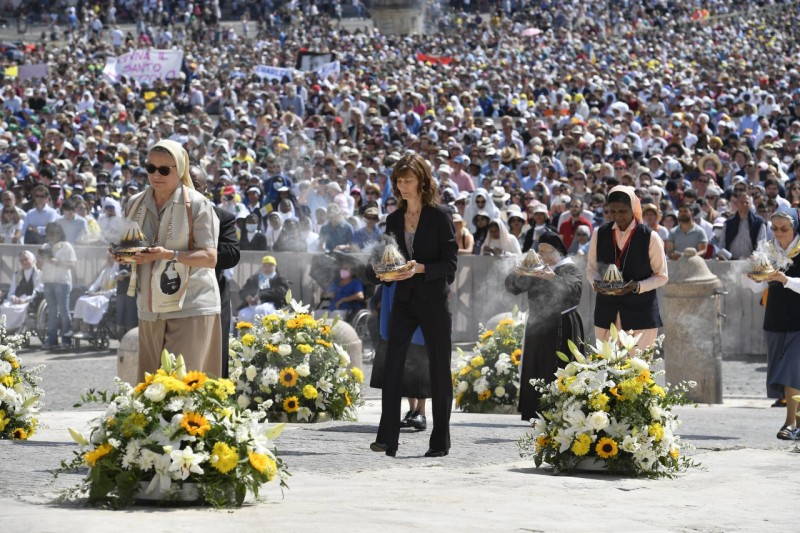
14 January
Feast
St Devasahayam Pillai (1712-1752)
Martyr of Christ in Kottar
Born Neelakanta Pillai
23 April 1712 Nattalam, Kanyakumari District, Kingdom of Travancore
Died 14 January 1752 (aged 39)
Aralvaimozhy, Kingdom of Travancore
Resting place Kottar, Nagercoil, India
Venerated in Catholic Church
Beatified 2 December 2012, Saint Francis Xavier Cathedral, Tamil Nadu, Nagercoil, India by Cardinal Angelo Amato (on behalf of Pope Benedict XVI)
Canonized 15 May 2022, Saint Peter’s Square, Vatican City by Pope Francis
Major shrine Cathedral of Saint Francis Xavier, Kottar, Nagercoil, India
Feast 14 January
Patronage India; Persecuted Christians
PRAYER
For the love of Christ you willingly and patiently underwent torments and tortures for three years, and willingly sacrificed your life and obtained the joy of eternal life and the veneration at the altars as God’s great reward. We praise and thank God for blessing you with this glorious life.
You set apart your whole life for preaching on the Kingdom of God, leaving behind all the worldly pleasures of wealth, status, name, fame and glory. You as a true disciple of Christ faithfully put into practice the values of the Gospel, the equality and fraternity of all people on earth.
Assist us to follow you in leaving behind all the worldly pleasures and help us to live as children of the kingdom of God and put into practice faithfully the values of the Gospel so that we may one day enter into eternal life to be with God and your company forever and ever.
O ! Blessed Devasahayam, Glorious Martyr! Pray For Us!

Lazarus Devasahayam: ‘A saint for new beginnings’
A Hindu-born man from Kanyakumari district in Tamil Nadu, who converted to Christianity in the 18th century, Lazarus Devasahayam is set to become the first Indian layman to be declared a saint on 15 May 2022.
By Linda Bordoni

Devasahayam, who took the name ‘Lazarus’ in 1745, was first approved for sainthood in February 2020 for “enduring increasing hardships” after he decided to embrace Christianity.
As the postulator for his cause, Father Joseph Elphinstone told Vatican Radio that Devasahayam is a poignantly significant figure for India today, as he embodies a model of fraternity and recognition of the dignity of all persons, regardless of religion or of social standing.
In fact, Fr Joseph explained, born to an upper-caste Hindu family, he embraced Christianity and championed the rights of India’s lowest castes preaching the equality of all people despite rigid caste differences. But first, he emphasized, this canonization is a high honour for the laity that is increasingly involved in the life of the Church and its people.Listen to Father Joseph Elphinstone
Father Elphinstone explained that this is a significant time for the Catholic Church in India, “a vibrant Church that is growing and is moving towards the laity,” a laity that is becoming more and more involved in different activities and is, in fact, “the centre the Church is trying to serve.” [READ ALSO 13/11/2021, Church in India: Devasahayam’s canonization a “historic moment”]
So, to have a layperson “being honoured and elevated to the highest rank is the best and highest honour we can give to the laity,” he said.
The fact that Devasahayam was able to do great things, contributing to the Church, to the community and to the people is being transmitted to Indians today, he continued, and thousands of people are flocking towards this saint.
He is a saint who is very concerned about people, “their problems, their worries, their differences, their cultures,” he said.
“So, it’s going to be a great beginning. He has left a great legacy for the Indian laity.”
A champion of equality
Lazarus Devasahayam has also left a great legacy in the field of rights, of equality, as he – a Hindu upper-class man who preached equality despite caste differences – was close to the marginalized as he followed the Gospel of Christ.
Father Joseph explained that “many may think that he was killed, martyred, just because of his conversion,” but that is not the case because in the kingdom of Travancore where he served and converted to Christianity, “the king himself built a small chapel for him, he appointed and paid for the chaplain,” and he worked alongside the Carmelite missionaries who were working there.
“What was not tolerated was that being a high caste man, he had no barriers after he became a Christian” and he forged ahead following God’s Word that all His children are equal.
“For him”, Fr Joseph said, “there was no barrier, no difference, no high and low, no rich and poor, no class caste.”
Christians, he said were considered a low and insignificant community and when this saint “freely started moving with them, chanting with them, celebrating with them, mingling with them, eating with them,” the high caste people in the palace could not tolerate it.
“His life became something which they couldn’t tolerate and that made them kill this saint.”
Devasahayam and a synodal Church
Devasahayam is particularly significant in today’s context, Father Joseph continued, also because he is totally in line with Pope Francis’ call to undertake a synodal process of collaboration, dialogue, listening, discerning.
Until now, he said, “we were not giving much importance to listening to the voice of the lower and the laity and the ordinary people. Now, this saint has given a new inspiration,” in this regard.
He pointed to the fact that every parish, every deanery, every diocese has started talking about what is the spirituality of this great saint; they have started conducting seminars, sitting together and having dialogues.
“And they would like to start a new centre where lay spirituality can be promulgated,” he noted: “So these are all new beginnings!”
What’s more, he continued, “he calls us also to listen to other religions, to different denominations – all of us together – not like simply our own people, our own Catholics, our own group.”
India today, Father Joseph said, needs to reflect on how to make a change. The caste divisions, he said, “are like cancer” in Indian society.
“We need to explore very much, reflect with him and promulgate the great values for which he lived and he died.”

A proud moment for the country
“It’s a proud moment, not only for the Tamil people, not only for Catholics in India,” Father Joseph said, but for everyone as witnessed by the fact that the government is sending three ministers to the canonization ceremony in Rome.
Indians, he said, have waited 270 years for this moment and they are celebrating with joy. In fact, he added, it is significant that, because of the conversion dimension involved, the canonization could have been instrumentalized by those who foster division. But happily, he said, “By God’s grace, we are having a peaceful coexistence and we are having a happy celebration.”
“We don’t wish that this saint, who worked for peace and unity, may become a symbol of division, jealousy and rivalry.” Father Joseph said the Indian Church’s perspective and focus is not on the conversion, but on the good values he lived and gave expression to.
The Canonization

Almost 6,000 people have applied for visas to travel to Rome for the Canonization. They are coming from India, Europe and the United States, Father Joseph concluded, expressing his personal sense of satisfaction and joy that his country has a saint who can become a symbol of bridge and communion.
“A unifier, a great person who can help everybody to respect other people and other religions, going beyond all divisions and showing us how to journey together towards a better life.”
A Courageous Convert and a Living Legend
Sunay, 2nd December 2012, Cardinal Angelo Amato beatifies Indian martyr Devasahayam Pillai
The beatification of India’s first married layman and martyr is important not only for Asia but for the millions of Christians who suffer in silence for their faith around the world. On Sunday, 2 December [2012], in the Diocese of Kottar, Cardinal Angelo Amato, Prefect of the Congregation for the Causes of Saints — on behalf of Benedict XVI — beatified Devasahayam Pillai (1712-1752), from the Kingdom of Thiruvithancore, today the Kannyakumari district in Tamil Nadu, India.
“Martyrdom and the vocation to martyrdom are not the result of human effort, but the response to an initiative and a call from God, they are a gift of his grace, which makes one capable of offering one’s life for love of Christ and of the Church, and thus of the world”. These words of Holy Father Benedict XVI (General Audience Catechesis, 11 August 2010), are fully applicable to the life, sufferings and the valiant death of the Blessed Servant of God Devasahayam Pillai.
Many may not have even heard the name Devasahayam Pillai, a mid-18th-century martyr of the Kingdom of Thiruvithancore, half of whose territory constitutes Kannyakumari district, Tamilnadu, South India. Devasahayam Pillai was born to an affluent and prosperous Hindu, Nair family (landlord and warrior caste at the time) in the year 1712 in a small hamlet called Nattalam. His name was Nilam or Nilakandan, and “Pillai” was a popular nomenclature referring to his high caste and social position. As a boy he learned Tamil and Malayalam, the languages of the people. He also studied Sanskrit, Hindu scriptures and trained in the traditional martial arts, archery, Varmasastra and the use of weapons. He became a high official in the palace, in charge of Nilakandaswamy Temple at Padmanabhapuram and an official in charge of the royal treasury, collecting materials for the construction of forts, payment of wages, etc. He married Bhargaviammal, a bride from an equally prominent Nair family.
Nilakandan Pillai experienced heavy losses of property and cattle which caused him great perturbation. Finding no relief in the performance of religious rituals to placate his family deity Bhadrakali in every possible way, he sought counsel from Eustachius Benedictus De Lannoy, a Dutch Catholic military officer, who was arrested by King Marthandavarma after the Dutch were defeated at the Port of Colachel in 1741. De Lannoy instructed him about the mystery of God’s loving providence in affliction, the Christian meaning of suffering in the Book of Job and the redemptive suffering of our Saviour. Nilakandan Pillai was impressed by Job’s absolute confidence in God in the face of unbearable tragedies. Convinced of the truth of Christian mysteries, Nilakandan Pillai expressed his desire to be baptized, fully aware of the extreme consequences which might befall him. Fr Giovanni Battista Buttari, a Jesuit Missionary at Vadakkankulam, about 30 kilometers away and outside the King’s domain, instructed him for nine months and baptized him on 14 May 1745. At baptism he received the name “Devasahayam” which is a Tamil rendering of the biblical name Lazarus, which means “God has helped”.
Having joined the Catholic community, Devasahayam Pillai returned home and continued his office at the royal palace for four years carrying out his duties with his usual efficiency and conscientiousness. On the side, he also started an apostolic mission of evangelizing people, including his own caste. His first convert was his wife Bhargaviamma. Highly educated and deeply rooted in the ancestral religion, at first she resisted but finally yielded to the grace of God. She took the name “Gnanapu” which is a Tamil rendering of “Theresa”. His continuous and courageous propagation of the faith, spreading the Good News, leading many to conversion and to Christ, while performing his high office at the King’s palace angered the Brahmins. The neophyte also mixed and mingled with people of every status and caste disregarding all caste distinctions. He threw away the symbols of his “high” caste (Ponool), ate and lived with people of “low” birth and returned to his office in the palace as a polluted person according to their custom and belief. He even dared to challenge the Brahmins in respect of their superstitions and heinous and inhuman oppression of the oppressed castes — among whom the vast majority were the Christians of the coastal Travancore. His new life became a cause of serious concern for all in the court and among high caste Hindus, who became his bitterest enemies. They accused him of the crime of betrayal, apostasy, contempt of religious practices and of insulting the Hindu gods, the Brahmins and the royal throne. Some even tried to woo him back from his new faith. But he showed great fortitude and firmness and even boldly declared that he was willing to be tortured and put to death for Christ.
The King, whose main preoccupation was preserving military and political tranquility in the Kingdom, finally gave in to the hostility of the royal coterie and caste Hindus against Devasahayam and let them have their way by dismissing him from office and had him arrested and put in a narrow prison on 23 February 1749. The following day he was condemned to death by the King, to be eliminated as “an enemy of the state”. Before execution the King again gave a fresh order to take him around through the most important and populous towns of the Kingdom for his ignominy. He was paraded in all the important towns in the Kingdom in a most shameful manner, seated backwards on a buffalo with an Erukku flower garland around his neck, his hands tied behind his back and the executioner holding the end of the rope by which the prisoner was bound in his left hand, and a sharp raised sword in his right hand. This was the ultimate kind of shame and mockery at that time.
When the parade was over, he was then handed over to soldiers for execution. Left under the open sky, he was tied to a neem tree with fetters, hugging the tree with his legs bound in chains so that he could not move, sit or stand or recline. He was exposed to the hot burning sun, heavy rains, very cold wind and sometimes was almost submerged in the slush. He endured these most grievous sufferings for seven months. In the midst of so much suffering, his only sorrow was the delay of death and his only fear was that he might lose the crown of martyrdom. Far from requesting or desiring to be set free from chains, which he did not allow the guards to remove them, and when the guards gave him a chance to escape, he simply refused.
Chained, he led a worthy and exemplary life of virtues, prayer, penance and mortification. Every morning and evening he took time for contemplation and often during the day, he prayed briefly and read books of piety, especially on the life of the saints. In addition, he fasted every Friday and Saturday (he was martyred in the middle of the night, between both days). He was always obedient to the priests and whenever possible, he confessed his sins and received Holy Communion with the utmost devotion. During imprisonment, only thrice could a priest make his way to him in the dead of night. His lifestyle coupled with the fame of miracles brought him many in great numbers and procured for him such veneration. He proclaimed Christ to all of them. Many who denied faith for fear of execution were persuaded by him to courageously return and repent. There are also many miraculous events because of the Martyr. He was brought to a small place called Puliyoorkurichy where, overcome by thirst, he planted his elbow on a rock, from which spouted water that he drank. This rock continues to give water and even now many people visit this fountain. Because of the prayers of Devasahayam, the jailer and executioner who was without a child for a long time obtained a child during his imprisonment in Peruvilai and became friendly with him.
The efforts of the guards to forbid the crowd from speaking to Devasahayam or from approaching and listening to him were in vain. The soldiers reported this to the King, from whom soon they got the order to secretly execute him. Finally, after three years of gruesome torture, he was taken to a secret prison at Aralvaimozhi, where condemned criminals were sentenced to death by the King. He had to be killed quickly and secretly because the Catholics began visiting the Servant of God in large numbers. The Government officials kept the place and the date of his execution secret for fear of popular unrest. Finally, a little before midnight between 14 and 15 January 1752, he was taken to the place of his execution. As he was lying totally exhausted and unable to walk, he was carried by the soldiers to the nearby hill, kattadimalai. There he knelt and prayed intensely. The marks left by his knees and elbows can be seen even today. There he was shot dead by the soldiers. As five bullets hit him, he uttered for the last time, “Jesus save me”. His body was cast away in to the forest to be torn up by the wild animals.
He had spent almost three years in fetters. Priests diligently tried in vain to in get hold of his body. At last, on the fifth day his bones were found shorn of flesh. His tongue was lying apart, incorrupt. They were gathered diligently and buried in front of the main altar of the famous church of St Francis Xavier, the present day Cathedral of the Diocese of Kottar. When the Bishop of the diocese heard of the heroic death of the Servant of God, he decreed that the Te Deum be sung in all churches in gratitude to God for “the palm of martyrdom” obtained by Devasahayam Pillai.
Soon after his death, the places connected to his life and death became important places of pilgrimage by all people. Many interior villages of the present district of Kanyakumari witnessed mass conversions to Catholic faith following his death, just as the mission work of St Francis Xavier was the main cause of conversions of the people along the coast. The name “Devasahayam” became one of the popular names for Catholics and non-Catholic Christians in the region. Following his martyrdom, he became a living legend and a venerated hero for the people of the region of Tamilnadu, Kerala, Sri Lanka and even beyond. Several narrations, poetry, folklore, stories and dramas were attributed to him depicting his heroic life and martyrdom.
Anyone who becomes acquainted with the outstanding life, conversion and martyrdom of Devasahayam Pillai must be totally perplexed as to why this famous and venerated martyr has been proclaimed a blessed after two and a half centuries. Why 260 years of delay on the part of everyone for promoting this cause? It is impossible to comprehend that in 18th century Devasahayam, a married layman, five days after his death, was buried in front of the main altar of the famous church of St Francis Xavier, unless he was popularly revered and even venerated during his life and after his death as a holy man. Still more remarkable, Devasahayam is like St Paul (an orthodox Pharisee who embraced Christ being fully aware of the inevitable consequences), an orthodox high caste man, who embraced Christianity for noble intentions, being aware of its extreme consequences to the fullest extent and lived and propagated his faith right where he was, in the royal court, an environment which was completely under the control of fanatically orthodox high caste people. In such a challenging situation he shed his blood, as a revolutionary, aggressively speaking for Christ and against the orthodoxy’s superstitions and extreme inhumanity.
The call to holiness is for everyone. But, in the history of the Church the vast majority of saints are from the class of religious men and women. In this context, the beatification of the first lay, married martyr in India, becomes a significant one. His sanctity is not only important for today’s universal Church, but also his zeal, courage and suffering can grant firmness, fortitude and solace to millions who are still silently suffering persecution in different parts of the world. Devasahayam paid the price for his faith in Christ even to the extent of radically renouncing anti-Gospel, anti-Christian values like caste system and other dehumanizing evils. His beatification is a call for all of us, now more than ever!
Taken from:
L’Osservatore Romano
Weekly Edition in English
5 December 2012, page 11
Other accounts at Wikipedia and Indian Catholic Matters